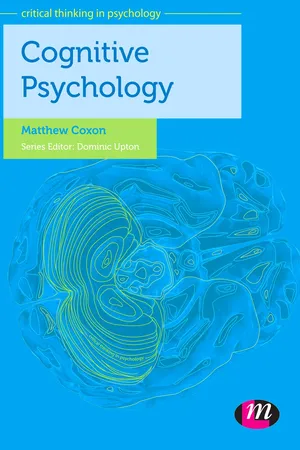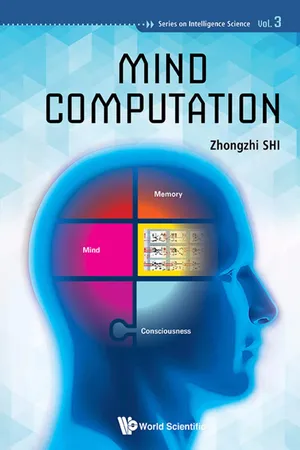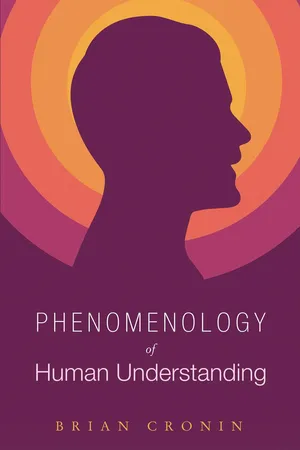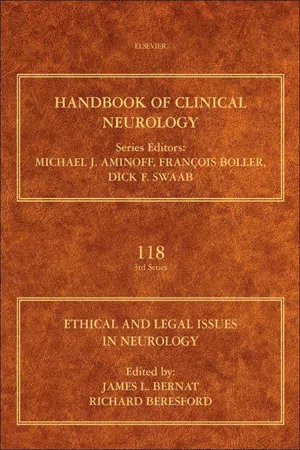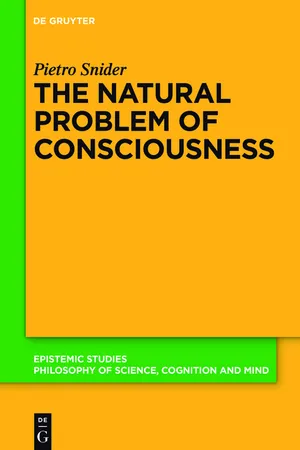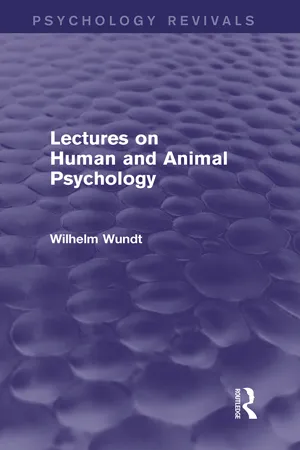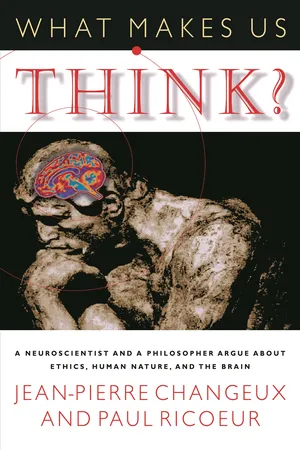Psychology
Defining consciousness
Defining consciousness refers to the attempt to understand and explain the state of being aware of and able to perceive one's surroundings and experiences. It involves exploring the nature of subjective experiences, self-awareness, and the ability to process information. This concept is central to the study of human cognition and behavior.
Written by Perlego with AI-assistance
Related key terms
Related key terms
1 of 4
Related key terms
1 of 3
10 Key excerpts on "Defining consciousness"
- eBook - ePub
- Matthew Coxon(Author)
- 2012(Publication Date)
- Learning Matters(Publisher)
neurobiologists. Consciousness has also received the continued attention of philosophers. Part of the challenge of consciousness is to determine which questions we can hope to possibly answer, and which ones we can't. In this chapter, we will start by considering some issues that are faced when trying to come up with a definition. For the remainder of the chapter we will consider what we can learn from the perspective of cognitive psychology. We will therefore be focusing on consciousness in terms of the scientific understanding of processes in the mind.Defining consciousness
To understand what cognitive psychology can contribute to debates about consciousness, we must first learn a little about what some of those debates are. The first is working out how best to define consciousness.Task
In your own words, try to define what consciousness means to you. You may want to consider what you mean if you say I am conscious of that, or what you understand if someone says that they were unconscious. Try to be as precise as possible.William James (1890) suggested that one important property of consciousness is the idea that it is something that we experience in a continuous way – what he called the stream of consciousness. One of the clearest examples of this is blinking. Although we blink regularly we do not experience a break in consciousness every time we blink. Instead, we experience the world as something consistent that exists all of the time.According to Velmans (2009) the simplest place to start is how we use the term consciousness in everyday language. The starting point is therefore the simple presence or absence of experienced phenomena. If I do not experience something, I am not conscious of it. If I do experience it, then I am.Interestingly, this feeling of consciousness consists of lots of different experiences that are specific to us. For example, I have no way of knowing if what I perceive as the ‘blueness’ of the cover of this book is the same as the ‘blueness’ that you experience. We have both learned a similar label (although you may be calling it ‘turquoise’), but there is no independent way of knowing that we are having exactly the same experience. These experiences in our consciousness are therefore unique to each individual and are qualitative (we cannot express them precisely in quantities or numbers). The word that has been used to label these types of experience is the word qualia. - eBook - ePub
- Zhongzhi Shi(Author)
- 2017(Publication Date)
- WSPC(Publisher)
In philosophy, consciousness is highly improving and a highly organized special material — the function of the human brain, and it is the reflection of the objective reality that is currently owned by mankind only. Consciousness is also the synonym of thinking, but the range of consciousness is relatively wide, including the cognition of emotional and rational stage, but thinking only means the cognition of rational stage. Dialectical materialism believes that consciousness is the result of high development of material, and it is the reflection of existence. There is also a huge activism role on existence.In medical science, the understanding of consciousness of different disciplines has some difference too. In the field of clinical medicine, the consciousness refers to patient’s understanding and reaction ability under surroundings and oneself. It is divided into different consciousness levels such as consciousness clearing, consciousness fuzzy, lethargy and coma. In spiritual medical science, consciousness differs between ego-consciousness and environmental awareness. Consciousness can become an obstacle in the form of clouding of consciousness, somnolence, stupor, coma, delirium, twilight state, dream-like state and confusion.The view on consciousness in psychology is awareness or experience of objective things on the external environment and one’s psychological activity, such as feeling, consciousness, attention, memory and thought. The evolutionary biologist and theoretical scientist Calvin lists some of the definitions of consciousness in the book How Brains Think [70 ].From the view of intelligence science, consciousness is the experience integration with the external world, one’s own body and mental process. Consciousness is “instinct” or “function” what is inherent in the brain, it is a “state”, and it is many biological “combinations” of a lot of brain structure. Generalized consciousness is the life phenomenon that all higher and lower organisms have. With biological evolution, there has been continuous progress of consciousness. It is mainly the brain which is the organ of human consciousness activity. In order to reveal the scientific law of consciousness, and building the brain model of consciousness, it is not merely needed to study the conscious cognitive process, but one must also to study the unconscious cognitive process, i.e., the automatic information process of the brain, and the transformation mechanisms of two processes in the brain. The consciousness research is the indispensable content in cognitive neuroscience. The research of consciousness and brain mechanism is an important content in natural science. Philosophy involves the study of problems such as the origin of consciousness and the authenticity of existing consciousness etc., the key area of study in intellectual scientific research of consciousness includes the brain mechanism of how consciousness is produced — how consciousness helps one to be aware of external objects. - eBook - ePub
- Elizabeth R. Valentine(Author)
- 2013(Publication Date)
- Routledge(Publisher)
293). Consciousness is peculiar in that one has special access to one’s own, but this does not detract in any way from the possibility of studying it scientifically. Conscious processes of others, unconscious mental processes and the external world all have the same epistemological status; namely, that of inferred constructs. Conscious experience provides data of the observer’s own consciousness immediately and directly, and of that of others mediately and indirectly through the observation of their behaviour, both in the form of what might be called ‘performance responses’ as well as by means of verbal reports, and of their neurophysiology. These observations are themselves part of consciousness. Thus consciousness provides data for all sciences but its status as subject matter in psychological science is that of an inferred construct. So far as psychology is interested in the processes underlying behaviour, this is true of all its subject matter. The use of introspective reports is discussed in Chapter 5. The Nature of Consciousness What is Consciousness? Consciousness has the paradoxical quality of being intuitively obvious, everyone having immediate knowledge of it, yet extremely difficult to define. Miller (1964) has drawn attention to the range of meanings it has had for different people: ‘a state of being, a substance, a process, a place, an epi-phenomenon, an emergent aspect of matter, or the only true reality’. The most basic sense of consciousness is in terms of experience or awareness. Many have emphasised this phenomenal aspect, for example Titchener (1899), for whom consciousness was ‘the sum total of a person’s experiences as they are at any given time’. An important distinction is that between consciousness in the sense of sensory experience – which Jackendoff (1987) terms ‘primary awareness’ – and a higher order self-consciousness in which one is aware of being aware (‘reflective consciousness’) - eBook - ePub
- Cronin(Author)
- 2017(Publication Date)
- Pickwick Publications(Publisher)
In teaching I used to approach the topic of consciousness with some trepidation, laden with bibliographies, references, definitions, and distinctions. The students would be equally in awe, brows furrowed, furiously taking notes, grappling with this most difficult of concepts. In my more mature years, I now begin with an exercise in awareness, a simple meditation, usually the one suggested at the beginning of this chapter. Students reported that it is quite difficult to attain complete stillness of the mind; it is easy enough to suspend thinking, but not so easy to stop images, memories, fantasies, and feelings that are flitting about, attracting us like little sprites. The point of the exercise is that whatever success you can have in arresting activities, there always remains some activity, with a conscious self, trying to be silent. Assuming that the students do not fall asleep, there is always a self that is aware—a subject that is conscious. The self is still around, whether that self is silent or distracted by plans for a night out. Consciousness is first and foremost a simple experience of awareness, of being conscious. That simple experience must be identified before moving on to the definitions! Consciousness is such a basic, simple, primordial, pervasive experience that it is difficult to put into words and articulate correctly. It is like what St. Augustine said about time: “We all know what it is but nobody can define it.”In conscious cognitional acts, such as thinking or deliberating, we are clearly aware of what we are thinking or deliberating about. But at the same time, in the same activity, we are immanently aware of the self, who is the subject of the activities. Consciousness is a quality of activities. Some activities such as thinking and deliberating are conscious; some activities such as digesting and growing are usually not conscious. To be conscious is simply to be aware of the subject at the same time as being aware of the object of the activity. Consciousness is not another activity added on to the activity of thinking; it is immanent in thinking.There is one awareness, which is normally focused on the object, with the subject implicit in the background. Consciousness is one awareness but it has two poles, namely, a primary awareness of the object and a concomitant accompanying awareness of the self as the subject of the awareness. If I am aware of typing on this computer, my main concentration is on the thoughts, sentences, keyboard, screen, and so on. But there is a concomitant awareness that it is I who is the self who is typing, I who is the self who is thinking, I who is the self who is looking. The key characteristic of consciousness is this experience of the subject concomitant with the experience of the object. It is nothing more complicated than the experience of watching a football match, but at the same time being aware that it is I - eBook - ePub
- James L. Bernat, Richard Beresford(Authors)
- 2014(Publication Date)
- Elsevier(Publisher)
We note that in eastern (Indian) philosophy, in contrast to the western tradition, mind and consciousness are distinguished: while the mind is physical and characterized by a link to intention and the contingent reality of sensation, consciousness is nonphysical, and reflects the irreducibly cognitive aspect of the universe (Rao, 1998, 2005). Three central intuitions recur repeatedly in western philosophic discussions of consciousness (Zeman, 2001, 2002). Philosophic accounts of consciousness can be helpfully judged against them. The first intuition is that consciousness, in the sense of awareness or experience, is a robust phenomenon, rich and real, that deserves to be explained by science and not “explained away.” Sensory experiences, for example, like those of color, sound, or pain, the simplest and most vivid instances of awareness, are phenomena that any full description of the universe must take seriously. Indeed, experiences of this kind are arguably our point of departure in gaining knowledge of the world. Consciousness, in this sense, is “the sea in which we swim” (Velmans, 2000). Almost everyone interested in the science and philosophy of consciousness would agree on these points in principle: but, of course, there is scope for plentiful disagreement about what is meant by the “reality” of awareness. The second intuition is that consciousness is bound up with our physical being. Everyone knows that fatigue, alcohol, knocks on the head, and countless other physical events can modify the state and contents of consciousness. The survey of the neurobiology of consciousness given above reinforces this prescientific view: consciousness is firmly rooted in the brain, and the structure of experience appears to be mirrored by the structure of neural processes - eBook - ePub
- Pietro Snider(Author)
- 2017(Publication Date)
- De Gruyter(Publisher)
In consciousness literature, however, this has not always been deemed necessary. Some think that consciousness is all too familiar to be given any sort of definition. Psychologist George Stout, for example, held that properly speaking a definition of consciousness is impossible, but that that is not necessary since “everybody knows what consciousness is because everybody is conscious” (1899, p. 7). Similarly, William James never attempted to define consciousness in his Principles of Psychology (1890) by virtue of the fact that it is a too familiar phenomenon that is accessible by introspection and therefore needs no definition. A similar approach can be found in Freud, saying “what is meant by consciousness we need not discuss; it is beyond all doubt” (1933, p. 70). More recently, neuroscientists Francis Crick and Christof Koch (1990, p. 263), in an attempt to lay out the foundations of a neurobiological theory of consciousness, hold that a precise definition of consciousness is not needed since “everyone has a rough idea of what is meant by consciousness”. I think that we should not take for granted that just because everyone is (or appears to be) conscious, everyone means the same thing when talking of “consciousness”. More than this, I believe that any work on consciousness underestimating the need for at least a rough characterization of the explananda is responsible for the confusion that still reigns today in consciousness studies as to what the term “consciousness” denotes. Some people however hold that we cannot give a clear and generally accepted definition of consciousness because there is no stable pretheoretical conception of it (cf. Titchener 1915, pp. 323–324). According to this interpretation, as Güzeldere (1997, p. 8.) puts it, consciousness “is a source of obscurity that remains typ ically recalcitrant to systematic investigation” - Wilhelm Wundt(Author)
- 2014(Publication Date)
- Routledge(Publisher)
discrimination; the word must be equivalent to discriminating activity. But here again the question arises whether the discrimination of processes directly perceived is the antecedent condition of these processes, or whether it is not rather a result to which they are essential. In the first place, the objects must be there to be distinguished. The child runs together a number of separate objects into a single idea, where the developed consciousness keeps them separate. Discrimination, then, like observation, consists in processes which presuppose consciousness, and which consequently cannot constitute its essence. And consciousness itself is not a particular mental process, coordinate with others; it consists entirely in the fact that we have internal experiences, that we perceive in ourselves ideas, feelings, and voluntary impulses. We are conscious of all these processes in having them; we are not conscious of them when we do not have them. Such expressions as ‘the limen of consciousness,’ ‘appearance in and disappearance from consciousness,’ etc., are pictorial ways of speaking, useful for the brief characterisation of certain facts of internal experience, but never to be regarded as a description of these facts. What really takes place in the raising of an idea above the limen of consciousness is, that something occurs which had not occurred previously. And what really happens when an idea disappears from it is that some process ceases which has hitherto been in progress. In like manner we must think of the range of consciousness as denoting simply the sum of mental processes existing at a given moment.Although, therefore, consciousness is not an especial kind of reality co-ordinate with the particular facts of consciousness, modern psychology still finds the concept indispensable. We must have a collective expression for the whole number of mental experiences, given either simultaneously or successively. As simply denoting the existence of internal experiences, while leaving their nature altogether undetermined, the concept is especially serviceable for the treatment of the interconnection of the mental facts, of all those processes with which we have already become acquainted in isolation. It has no meaning apart from its reference to this interconnection of simultaneous and successive mental processes; and the problem of consciousness consists in determining how the particular phenomena are interrelated, and how their relations and connections again combine to form the totality of mental life. For the sake of simplicity in treatment, it will be convenient to confine ourselves at first to the ideational side of consciousness, and then, when we have discussed the problem just formulated from this point of view, to supplement our results by reference to the affective and conative elements. This is of course the plan which we have followed in our analysis of particular mental processes. It will, however, soon become evident that in dealing with the interconnections of mental processes we cannot carry our abstraction through to the end, since the affective side of our mental life constantly exercises a determining influence upon the combinations and relations of ideas. In certain instances, therefore, we shall not be able to avoid at least a passing reference to the affective and conative factors.- eBook - ePub
Contemporary Psychoanalytic Foundations
Postmodernism, Complexity, and Neuroscience
- Mark Leffert(Author)
- 2011(Publication Date)
- Routledge(Publisher)
This is regrettable in that the psychoanalytic situation offers a unique opportunity to observe consciousness in action, through inference based on the patient’s communications, unpredictable self-reports, and the analyst’s scrutiny of his own conscious experience. In making inferences (Collins, Mann, Hill, Dommett, & Greenfield, 2007) about a patient’s consciousness, the therapist is also able to observe differences across contexts and that different people can inhabit vastly different psychological worlds. Different sources of observational data provide strong evidence that consciousness, autonoetic consciousness, awareness of self, and awareness of being aware differ greatly across individuals in quality, character, and duration. Psychoanalysis has much to offer as well as much to gain from cognitive psychology and neuroscience pertaining to consciousness. Postmodernism also provides its own unique collection of insights into consciousness.Consciousness and Postmodernism
Postmodernism offers two contributions to the study of consciousness, both of which not only can inform neuroscience and cognitive psychology but also will require them to adjust to this (to them) novel information. The first has to do with the relations between consciousness, the self, and the external world, and the second involves a critique of the types of knowledge claims that these disciplines are entitled to make about consciousness. This critique of epistemological standing will lead to a discussion of the contributions of complexity and systems theory.Consciousness, the Self, and the External World
When discussing consciousness and its relation to the mind/brain, it is all too easy to lose track of the relationship of consciousness to the external world. One aspect of those relations with the environment, seeing, appears developmentally out of the growing integration of sensory stimuli. Another aspect of the relationship of consciousness to the environment has to do with social relations, how it is influenced by the nature and quality of the manner in which the self is embedded in the social matrix. Neuroscience studies of the mirror neuron system (MNS) provided a crucial bridge between the social and the neuroscientific, a bridge informed by the field of science studies (Latour, 1999). Mirror neurons were only discovered about 10 years ago (Gallese, Fadiga, Fogassi, & Rizzolatti, 1996) in the inferior frontal cortex of macaque monkeys. They are also found in the prefrontal motor, visual, and somatosensory areas of the cerebral cortex in humans (Iacoboni, 2007; Iacoboni et al., 1999). The MNS does not function consciously. The MNS is activated in an individual if the individual observes goal-oriented action, behavior, or feeling in another and then, well, mirrors it. When an action is performed by an individual, there is an unconscious tendency (which can become conscious) on the part of an observer to imitate or mirror the action, sometimes actually expressed, sometimes not. The MNS is also activated when an individual observes another’s action and thinks about performing it. In both instances, the observer’s MNS is activated in the same way.22 Watching someone being tickled or imagining being tickled produces some feeling of being tickled in us. All of these observations reflect the same MNS activity. The same - eBook - ePub
Consciousness
The Science of Subjectivity
- Antti Revonsuo(Author)
- 2009(Publication Date)
- Psychology Press(Publisher)
Science is an attempt to build models of the world that faithfully reflect reality and help us humans to systematize and understand what kind of phenomena there are in the world, how they are organized and related to each other and how they work. Reality at large seems to be hierarchically organized, a multilayered but interconnected whole. Thus, we have different kinds of conceptual systems – different branches of science – that are specialized in studying particular layers of the world. There is the purely physical world studied by physics, the chemical world of chemical elements and compounds studied by chemistry, the biological world of living entities investigated by biology, the neural world of the brain studied by neuroscience and, finally, the psychological reality studied by psychology.The science of consciousness studies the reality of our conscious life – our psychological lives as streams of subjective experiences – and therefore we need a conceptual framework or a model that describes this reality. A science can only be as clear as the basic concepts and definitions it has to offer concerning the basic phenomena in the reality it investigates. The concept of consciousness is notoriously vague and ambiguous. There are many different usages and definitions of the concept of consciousness, especially in everyday language. Unfortunately a similar conceptual confusion has reigned also in the scientific study of consciousness, at least in its initial stages.But now that the modern scientific study of consciousness has put some effort into defining what consciousness really is, it is possible to characterize the basic concepts needed to describe consciousness in a clear and unambiguous way. Of course, not everyone working in this new field would agree completely with the definitions and characterizations of consciousness presented here. Only time will tell if these are the definitions that will survive as the basic vocabulary of the science of consciousness in the long run. In any case, at this stage the concepts defined below form the very basics of the science of consciousness. - eBook - ePub
What Makes Us Think?
A Neuroscientist and a Philosopher Argue about Ethics, Human Nature, and the Brain
- Jean-Pierre Changeux, Paul Ricoeur, M. B. DeBevoise, M. B. DeBevoise(Authors)
- 2021(Publication Date)
- Princeton University Press(Publisher)
4 - Consciousness of Oneself and of OthersConscious Space
Jean-Pierre Changeux: The activity of communicating, of making oneself understood, occurs among alert and conscious subjects. The problems associated with consciousness need to be approached with care. I will try first to define the notion of conscious space. This may be thought of as a sort of milieu intérieur —a neural setting within the brain, still very poorly described by the neurosciences, for operations that are qualitatively distinct from those carried out in the other unconscious parts of our brain and our nervous system. This space is given over to simulation, to virtual action. Its development from lower vertebrates to humans is dazzling. Although it is internal to the organism, it is somehow inserted between the external world and the organism. At this level one finds intentions, goals, plans, courses of action evaluated with constant reference to (at least) four poles involving distinct systems of neurons: actual interaction with the external world—this opening onto the world that you yourself have mentioned; the self and the whole of an individual’s history, which takes the form of remembered events, of a narrative reconstituted from one’s own life and the memory of prior experiences marked somatically by their emotional tone; and, finally, internalized rules and social conventions, as well as those global conceptions of man and society that each person tacitly carries within himself or herself. Here I recall your definition of narration—a concrete example if ever there was one of the operations carried out in the conscious space of the brain—as “deploying an imaginary space for thought experiments in which moral judgment operates in a hypothetical mode.”1
Index pages curate the most relevant extracts from our library of academic textbooks. They’ve been created using an in-house natural language model (NLM), each adding context and meaning to key research topics.
Explore more topic indexes
Explore more topic indexes
1 of 6
Explore more topic indexes
1 of 4
